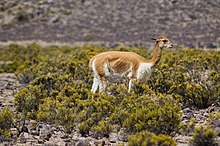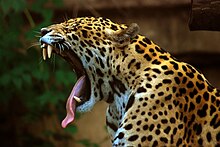Wildlife of peru
The Peruvian fauna is made up of all the animal species found in its territory. Many of the native species are legally protected to preserve their conservation and that of their natural resources.
Peruvian fauna is part of the country's great biodiversity, as diverse as its geography and climate.
Marine fauna
It comes from three centers of origin: from the warm, pederator (equatorial current), from the cold (Peruvian current), and from the frequent contributions from distant Antarctica.
Tropical
It is a warm marine current known as the equatorial current or also the El Niño current. They predominate in the correction of the tropical sea with an average temperature of around 24 °C, off the regions of Tumbes and northern Piura. This warm current exerts its power during the months of spring (October to December) and summer (January to April) where it is observed to influence further south up to latitude 6º 00' 00" until colliding with the Humboldt Cold Current in the province of Sechura.
This warm ocean current, with temperatures that fluctuate from day to night between 26 and 22 °C, extends from the Sechura region in the Pacific Ocean to the Baja California region in Mexico. Among its most representative components are the sea snake (plarmis platurus); various typical birds, such as the frigate and the booby; five species of sea turtles and more than a hundred fish, such as sharks, merlins and groupers. Also on these coasts you can find the greatest variety of molluscs in Peru, especially many species of gastropods and bivalves.
Humboldt Current
This cold current of Antarctic origin has temperatures that oscillate between 19 and 14 C°. Its presence predominates from the department of Tacna and continues its course to the province of Sechura, 6º 00´ 00" latitude south of the equator, where it diverts towards the Galapagos Islands during the summer and spring months.
In this bold current, which averages a temperature of 17 °C, there are hundreds of endemic species, standing out for their production of sea bass, sole, anchovy, bonito and giant squid, of which the fish meal and squid meal for human consumption; in addition to numerous crustaceans and mollusks; among six hundred other species. In addition, birds that are economically important due to the guano they deposit on the Peruvian coast, having given rise to guano deposits that are used as fertilizer in agriculture.
Antarctic Current
In a small proportion it contributes sea lions, sperm whales, whales and dolphins.
Terrestrial fauna
Two very different groups are distinguished by their origin:
Andean
As a general feature, they are adapted to the scarcity of resources, due to the climatic impact of the particular Andean morphology. The coast is poor in species and there are species such as the hairless dog, which has existed in this area for thousands of years, such as the guinea pig, the deer, the skunk , the iguana, the giant tortoise and others. The 54 rivers that bathe the coast have different varieties of fish and shrimp are exploited in some
In the mountains, on the other hand, the auquénidos (alpaca, guanaco, llama and vicuña) are representative, so important in the economy of the Andean communities; and birds like the condor. There are also chinchillas, vizcachas and since the last decade of the XX century, ostriches that were imported for breeding on an ever-larger scale. due to its good acclimatization near Arequipa ostrich meat. The lakes and rivers in this area have their own diverse fauna. It is made up of birds such as seagulls, parihuanas, patillos and grebes and a wide variety of native fish.
Amazonian
Originated from the central plain of South America, they are characterized by having great adaptability to humid areas. They inhabit the jungle and the areas adjacent to the tropical sea. The jaguar, large snakes, alligators, wild boars, etc. are representative. Millions of known and unknown insects and birds such as macaws, parrots, and thousands more known and to be classified. The Amazon River has species of all natures yet to be classified. In addition to fish in the rivers there are alligators and turtles, but their fishing is definitely prohibited.
The center of evolution of the Chaco is responsible for the origin of a small proportion of the Peruvian fauna, which inhabits the palm savannah, which covers a small area of the Madre de Dios region. Animals such as the maned wolf, marsh deer and 17 species of birds are found here.
The jungle has a diversified fauna, highlighting the presence of jaguars, pumas, large snakes, crocodiles, wild boars, parrots, parrots, and a large number of birds.
Species by taxonomic group
Mammals
In Peru there are currently 559 species of mammals.
Birds
Peru has more than 1,800 species of birds, making it the second country in the world in bird biodiversity behind Colombia. But Peru has 103 endemic birds, compared to 83 Colombian endemic species. Unfortunately, there are 83 globally threatened species.
Amphibians
There are 576 amphibian species registered in Peru. They are distributed in 3 orders, 20 families and 79 genera.
Reptiles
There are 93 species of reptiles registered in Peru. They are distributed in 3 orders, 32 families and 125 genera.
Insects
Peru ranks first in butterfly variety with 4,441 species.
Fish
It has about 2,000 species of fish representing 10% of the world total, which places it in first place.
Contenido relacionado
Q fever
Daucus carota
Daknopholis boivinii




